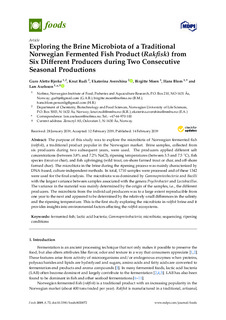Exploring the brine microbiota of a traditional Norwegian fermented fish product (Rakfisk) from six different producers during two consecutive seasonal productions
Bjerke, Guro alette; Rudi, Knut; Avershina, Ekaterina; Moen, Birgitte; Blom, Hans; Axelsson, Lars Torsten
Peer reviewed, Journal article
Published version
Permanent lenke
http://hdl.handle.net/11250/2620054Utgivelsesdato
2019Metadata
Vis full innførselSamlinger
Sammendrag
The purpose of this study was to explore the microbiota of Norwegian fermented fish (rakfisk), a traditional product popular in the Norwegian market. Brine samples, collected from six producers during two subsequent years, were used. The producers applied different salt concentrations (between 3.8% and 7.2% NaCl), ripening temperatures (between 3.5 and 7.5 °C), fish species (trout or char), and fish upbringing (wild trout, on-shore farmed trout or char, and off-shore farmed char). The microbiota in the brine during the ripening process was mainly characterized by DNA-based, culture-independent methods. In total, 1710 samples were processed and of these 1342 were used for the final analysis. The microbiota was dominated by Gammaproteobacteria and Bacilli with the largest variance between samples associated with the genera Psychrobacter and Lactobacillus. The variance in the material was mainly determined by the origin of the samples, i.e., the different producers. The microbiota from the individual producers was to a large extent reproducible from one year to the next and appeared to be determined by the relatively small differences in the salinity and the ripening temperature. This is the first study exploring the microbiota in rakfisk brine and it provides insights into environmental factors affecting the rakfisk ecosystems.
